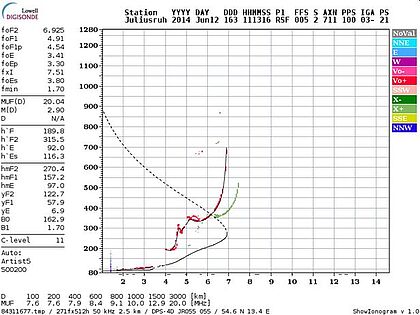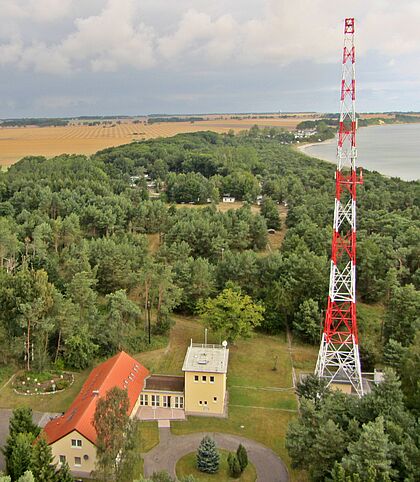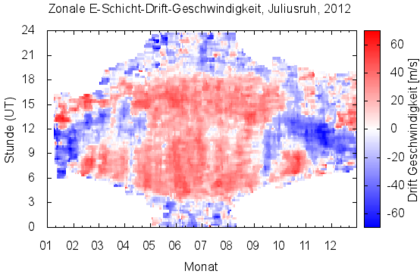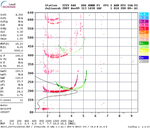The Ionosonde Juliusruh
The IAP field station in Juliusruh is well known and scientifically valued for its more than 60 years of continuous ionosonde measurements of high quality. It provides one of the longest and most valuable time series of the IAP.
Since the upgrade to the ionosonde type Digisonde DPS-4D, in addition to the regular standard ionograms, drift measurements in the E and F layers are also possible.
Besides the recording of regular 5-minute vertical ionograms for monitoring and predicting the ionospheric conditions, since 2017 the IAPs ionosonde has been a receiving station for oblique transmission links for near-real-time detection of Traveling Ionospheric Disturbances (TID) within the European TechTIDE project. For this purpose, the ionosonde signals of the Digisondes in Dourbes (Belgium, approx. 780 km west) and in Prague (Czech Republic, approx. 520 km) are observed and evaluated. Despite the end of the TechTIDE project in 2020, measurements are continued under TechTIDE-Follow-up without external funding.
In order to be able to process and distribute the data in near-real-time, the ionosonde was updated due to a major maintenance in March 2019, where hardware and software components were renewed.
A detailed technical specification as well as a description of the hardware and software of the Digisonde can be found under the link to the manufacturer LDI.
The ionosonde Juliusruh is part of the international ionosonde network GIRO (Global Ionospheric Radio Observatory) and the European ionosonde network DIAS (DIgital upper Atmosphere Server).
Measuring principle - vertical sounding:
In the frequency range between 1 and 20 MHz short electromagnetic pulses are vertically transmitted into the ionosphere and are received locally after their ionospheric reflection. From the ionospheric echoes their amplitude, travelling time (virtual reflection height), Doppler shift, polarization, angle of arrival and the electron density profile are derived and presented in a so called ionogram in dependence on frequency.

Messprinzip - Drift-Modus
Ionosonden-Driftmessungen basieren auf der Abschätzung der Doppler-Verschiebung des ionosphärischen Plasmas in einem Bereich von bis zu 400 km Durchmesser lokal über der Messstation. Seit kurzem werden die monostatischen Driftmessungen über Juliusruh mit den Möglichkeiten der Vorwärtsstreuung ergänzt. Diese erlauben den Empfang gesendeter Signale anderer Digisonden, die einige hundert Kilometer von Juliusruh entfernt sind (TechTIDE).
Besides the scientific aspects of ionograms, the continuous measurements are used routinely to monitor and forecast the current ionospheric conditions. More recently such routine observations are complemented with forward scatter capabilities, allowing the reception of transmitted signals from other Digisondes located few hundreds of kms from Juliusruh. The ionosonde Juliusruh is part of the international Digisonde network GIRO (Global Ionospheric Radio Observatory) and the European ionosonde network DIAS (DIgital upper Atmosphere Server).
Technical specifications
| Frequency range | 1 to 15 MHz (0.5 to 30 MHz) |
| Peak power | max. 2x 150 W |
| Pulse width | 533µs (16x 33µs) |
| Transmitting antenna | 2 crossed rhombus antennas (70 m tower) |
| Receiving antenna | 4 crossed loop antennas |
| Height resolution | 1 - 2.5 km |
Publications
- Arthur Amaral Ferreira, Claudia Borries, Chao Xiong, Renato Alves Borges, Jens Mielich and Daniel Kouba, Identification of potential precursors for the occurrence of Large-Scale Traveling Ionospheric Disturbances in a case study during September 2017, Journal of Space Weather and Space Climate, https://doi.org/10.1051/swsc/2020029, 2020
- M.A. Chernigovskaya, B.G. Shpynev, A.S. Yasyukevich, D.S. Khabituev, K.G. Ratovsky, A.Yu. Belinskaya, A.E. Stepanov, V.V. Bychkov, S.A. Grigorieva, V.A. Panchenko, D. Kouba, J. Mielich, Longitudinal variations of geomagnetic and ionospheric parameters in the Northern Hemisphere during magnetic storms according to multi-instrument observations Advances in Space Research, https://doi.org/10.1016/j.asr.2020.10.028, 2020
- M. A. Chernigovskaya, B. G. Shpynev, A. S. Yasyukevich, A. A. Mylnikova, D. S. Khabituev, P. Koucká Knivzová, D. Kouba, J. Mielich und A. Kozlovsky, Ionospheric variability over europe in winter from the ionosonde and gps/glonass data, Current problems in remote sensing of the Earth form space, 15, 295-307, doi:10.21046/2070-7401-2018-15-4-295-307, 2018.
- B. Reinisch, I. Galkin, A. Belehaki, V. Paznukhov, X. Huang, D. Altadill, D. Buresova, J. Mielich, T. Verhulst, S. Stankov, E. Blanch, D. Kouba, R. Hamel, A. Kozlov, I. Tsagouri, A. Mouzakis, M. Messerotti, M. Parkinson und M. Ishii, Pilot ionosonde network for identification of travelling ionospheric disturbances, Radio Sci., 53, 365-378, doi:10.1002/2017RS006263, 2018
- C. Borries, N. Jakowski, K. Kauristie, O. Amm, J. Mielich und D. Kouba, On the dynamics of large-scale traveling ionospheric disturbances over Europe on 20 November 2003, J. Geophys. Res., 122, 1199-1211, doi:10.1002/2016JA023050, 2017.
- N. Jakowski, M. M. Hoque, J. Mielich und C. Hall, Equivalent slab thickness of the ionosphere over Europe as an indicator of long-term temperature changes in the thermosphere, J. Atmos. Solar-Terr. Phys., 163, 91-102, doi:10.1016j.jastp.2017.04.008, 2017.















